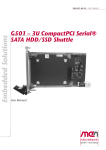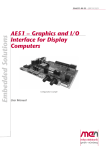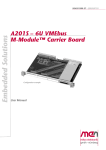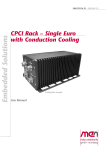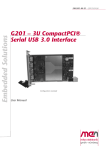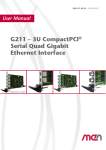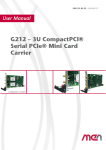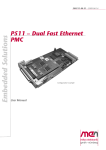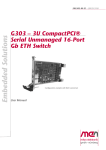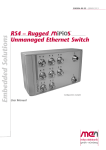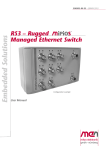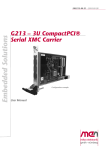Download MEN Mikro F100 Manual
Transcript
Embedded Solutions
20G100-00 E1 – 2010-11-30
G100/F100 CompactPCI®
Serial to CompactPCI®
Interface Cards
F100
G100
Configuration examples
User Manual
®
G100/F100 - CompactPCI® Serial to CompactPCI® Interface Cards
G100/F100 - CompactPCI® Serial to CompactPCI® Interface
Cards
The G100/F100 board combination is used to connect a CompactPCI® Serial
system to a CompactPCI® system. The CompactPCI® Serial backplane and the
CompactPCI® backplane can either be located in one housing or in two separate
ones.
The G100 is plugged into a peripheral slot of a CompactPCI® Serial system, It uses
one PCI Express® x1 link from the backplane and leads it to the front to an 18-pin
PCI Express® connector.
The F100 is plugged into the system slot of the CompactPCI® system. It is
equipped with a PCI-Express-to-PCI bridge which acts as a master for up to 7 PCI
devices. It supports 32-bit and 33-MHz. Optionally the F100 can also be used
without the G100 if the PCI Express® x1 link is led to the board via the backplane.
For this, a special backplane is needed, however. Another possibility is to directly
control a CompactPCI® system using an external PC (e.g. a notebook) for
evaluating or programming the application.
The G100 and the F100 are connected via the front using a PCI Express® cable
which can have a length of up to 7 m.
The boards are qualified for operation in the extended temperature range of -40 up
to +85°C.
MEN Mikro Elektronik GmbH
20G100-00 E1 – 2010-11-30
2
Technical Data
Technical Data
General Functionality
• Connection of a CompactPCI® Serial system to a CompactPCI® system
PCI Express® Connection
• One x1 link on 18-pin front connectors
- According to PCI Express® Cabling Specification Rev. 1.0
• Data rate 250 MB/s
G100
• PCI Express® buffer
- For decoupling the backplane PCI Express® interface from the front interface
• CompactPCI® Serial
- Compliance with CompactPCI® Serial Specification CPCI-S.0 (proposed
standard currently under development)
- Peripheral slot
- Host interface: one PCI Express® lane
F100
• PCI-Express-to-PCI bridge
- Supports up to 7 PCI devices as a master
• CompactPCI® Bus
- Compliance with CompactPCI® Core Specification PICMG 2.0 R3.0
- System slot
- 32-bit/33-MHz PCI-Express-to-PCI bridge
- V(I/O): +3.3 V (+5 V tolerant)
Electrical Specifications
• F100 supply voltage/power consumption:
- +5 V (+/-10%), 5 mA typ.
- +3.3 V (+/-10%), 700 mA typ.
• G100 supply voltage/power consumption:
- +12V (-10%/+10%), 50 mA typ.
Mechanical Specifications
• Dimensions: conforming to CompactPCI® specification for 3U boards
• Weight:
- F100: 132 g
- G100: 116 g
MEN Mikro Elektronik GmbH
20G100-00 E1 – 2010-11-30
3
Technical Data
Environmental Specifications
• Temperature range (operation):
- -40..+85°C (qualified components)
- Airflow: min. 1.0 m/s
• Temperature range (storage): -40..+85°C
• Relative humidity (operation): max. 95% non-condensing
• Relative humidity (storage): max. 95% non-condensing
• Altitude: -300 m to + 3,000 m
• Shock: 15 g, 11 ms
• Bump: 10 g, 16 ms
• Vibration (sinusoidal): 1 g, 10..150 Hz
• Conformal coating on request
MTBF
• F100: 1,763,401 h @ 40°C according to IEC/TR 62380 (RDF 2000)
• G100: 2,585,957 h @ 40°C according to IEC/TR 62380 (RDF 2000)
Safety
• PCB manufactured with a flammability rating of 94V-0 by UL recognized manufacturers
EMC
• Conforming to EN 55022 (radio disturbance), IEC1000-4-2 (ESD) and
IEC1000-4-4 (burst)
MEN Mikro Elektronik GmbH
20G100-00 E1 – 2010-11-30
4
Block Diagram
Block Diagram
F100
optional
J2
PCI Express x1
PCIE to PCI
Bridge
PCIPCI
J1
Cable
G100
PCI Express x1
PCI Express x1
Buffer
P1
MEN Mikro Elektronik GmbH
20G100-00 E1 – 2010-11-30
5
Configuration Options F100
Configuration Options F100
PCI Express®
• PCI Express® link from rear I/O connector J2 (requires special backplane)
CompactPCI Bus
• 66 MHz with support for up to 4 PCI slots
Please note that some of these options may only be available for large volumes.
Please ask our sales staff for more information.
For available standard configurations see online data sheet.
MEN Mikro Elektronik GmbH
20G100-00 E1 – 2010-11-30
6
Product Safety
Product Safety
!
Electrostatic Discharge (ESD)
Computer boards and components contain electrostatic sensitive devices.
Electrostatic discharge (ESD) can damage components. To protect the board and
other components against damage from static electricity, you should follow some
precautions whenever you work on your computer.
• Power down and unplug your computer system when working on the inside.
• Hold components by the edges and try not to touch the IC chips, leads, or circuitry.
• Use a grounded wrist strap before handling computer components.
• Place components on a grounded antistatic pad or on the bag that came with the
component whenever the components are separated from the system.
• Store the board only in its original ESD-protected packaging. Retain the original
packaging in case you need to return the board to MEN for repair.
MEN Mikro Elektronik GmbH
20G100-00 E1 – 2010-11-30
7
About this Document
About this Document
This user manual describes the hardware functions of the board, connection of
peripheral devices and integration into a system. It also provides additional
information for special applications and configurations of the board.
The manual does not include detailed information on individual components (data
sheets etc.). A list of literature is given in the appendix.
History
Issue
E1
Comments
First issue
Date
2010-11-30
Conventions
!
italics
bold
monospace
hyperlink
This sign marks important notes or warnings concerning proper functionality of the
product described in this document. You should read them in any case.
Folder, file and function names are printed in italics.
Bold type is used for emphasis.
A monospaced font type is used for hexadecimal numbers, listings, C function
descriptions or wherever appropriate. Hexadecimal numbers are preceded by "0x".
Hyperlinks are printed in blue color.
The globe will show you where hyperlinks lead directly to the Internet, so you can
look for the latest information online.
IRQ#
/IRQ
Signal names followed by "#" or preceded by a slash ("/") indicate that this signal is
either active low or that it becomes active at a falling edge.
in/out
Signal directions in signal mnemonics tables generally refer to the corresponding
board or component, "in" meaning "to the board or component", "out" meaning
"coming from it".
MEN Mikro Elektronik GmbH
20G100-00 E1 – 2010-11-30
8
About this Document
Legal Information
MEN Mikro Elektronik reserves the right to make changes without further notice to any products herein. MEN makes no
warranty, representation or guarantee regarding the suitability of its products for any particular purpose, nor does MEN assume
any liability arising out of the application or use of any product or circuit, and specifically disclaims any and all liability,
including without limitation consequential or incidental damages.
"Typical" parameters can and do vary in different applications. All operating parameters, including "Typicals" must be
validated for each customer application by customer's technical experts.
MEN does not convey any license under its patent rights nor the rights of others.
Unless agreed otherwise, MEN products are not designed, intended, or authorized for use as components in systems intended
for surgical implant into the body, or other applications intended to support or sustain life, or for any other application in which
the failure of the MEN product could create a situation where personal injury or death may occur. Should Buyer purchase or
use MEN products for any such unintended or unauthorized application, Buyer shall indemnify and hold MEN and its officers,
employees, subsidiaries, affiliates, and distributors harmless against all claims, costs, damages, and expenses, and reasonable
attorney fees arising out of, directly or indirectly, any claim of personal injury or death associated with such unintended or
unauthorized use, even if such claim alleges that MEN was negligent regarding the design or manufacture of the part.
Unless agreed otherwise, the products of MEN Mikro Elektronik are not suited for use in nuclear reactors or for application in
medical appliances used for therapeutical purposes. Application of MEN products in such plants is only possible after the user
has precisely specified the operation environment and after MEN Mikro Elektronik has consequently adapted and released the
product.
ESM™, ESMini™, MDIS™, MDIS4™, MDIS5™, MENMON™, M-Module™, M-Modules™, SA-Adapter™, SAAdapters™, UBox™, USM™ and the MBIOS logo are trademarks of MEN Mikro Elektronik GmbH. PC-MIP® is a
registered trademark of MEN Micro, Inc. and SBS Technologies, Inc. MEN Mikro Elektronik®, ESMexpress®, MIPIOS®
and the MEN logo are registered trademarks of MEN Mikro Elektronik GmbH.
CompactPCI®, CompactPCI® Express, CompactPCI® PlusIO and CompactPCI® Serial are registered trademarks of the PCI
Industrial Computer Manufacturers Group. COM Express™ is a trademark of PCI Industrial Computer Manufacturers Group.
PCI Express® and PCIe® are registered trademarks of PCI-SIG.
All other products or services mentioned in this publication are identified by the trademarks, service marks, or product names
as designated by the companies who market those products. The trademarks and registered trademarks are held by the
companies producing them. Inquiries concerning such trademarks should be made directly to those companies. All other brand
or product names are trademarks or registered trademarks of their respective holders.
Information in this document has been carefully checked and is believed to be accurate as of the date of publication; however,
no responsibility is assumed for inaccuracies. MEN Mikro Elektronik accepts no liability for consequential or incidental
damages arising from the use of its products and reserves the right to make changes on the products herein without notice to
improve reliability, function or design. MEN Mikro Elektronik does not assume any liability arising out of the application or
use of the products described in this document.
Copyright © 2010 MEN Mikro Elektronik GmbH. All rights reserved.
Please recycle
Germany
MEN Mikro Elektronik GmbH
Neuwieder Straße 5-7
90411 Nuremberg
Phone +49-911-99 33 5-0
Fax +49-911-99 33 5-901
E-mail [email protected]
www.men.de
MEN Mikro Elektronik GmbH
20G100-00 E1 – 2010-11-30
France
MEN Mikro Elektronik SA
18, rue René Cassin
ZA de la Châtelaine
74240 Gaillard
Phone +33 (0) 450-955-312
Fax +33 (0) 450-955-211
E-mail [email protected]
www.men-france.fr
USA
MEN Micro, Inc.
24 North Main Street
Ambler, PA 19002
Phone (215) 542-9575
Fax (215) 542-9577
E-mail [email protected]
www.menmicro.com
9
Contents
Contents
1 Getting Started . . . . . . . . . . . . . . . . . . . . . . . . . . . . . . . . . . . . . . . . . . . . . . . . 13
1.1 Map of the Board. . . . . . . . . . . . . . . . . . . . . . . . . . . . . . . . . . . . . . . . . 13
1.2 Integrating the Board into a System . . . . . . . . . . . . . . . . . . . . . . . . . . 14
2 Functional Description . . . . . . . . . . . . . . . . . . . . . . . . . . . . . . . . . . . . . . . . . .
2.1 Power Supply. . . . . . . . . . . . . . . . . . . . . . . . . . . . . . . . . . . . . . . . . . . .
2.1.1
F100 . . . . . . . . . . . . . . . . . . . . . . . . . . . . . . . . . . . . . . . . . . .
2.1.2
G100 . . . . . . . . . . . . . . . . . . . . . . . . . . . . . . . . . . . . . . . . . . .
2.2 PCI Express Connection . . . . . . . . . . . . . . . . . . . . . . . . . . . . . . . . . . .
2.3 F100 PCI Express to PCI Bridge. . . . . . . . . . . . . . . . . . . . . . . . . . . . .
2.4 G100 PCI Express Buffer . . . . . . . . . . . . . . . . . . . . . . . . . . . . . . . . . .
2.5 F100 CompactPCI Interface . . . . . . . . . . . . . . . . . . . . . . . . . . . . . . . .
2.6 G100 CompactPCI Serial Interface . . . . . . . . . . . . . . . . . . . . . . . . . . .
2.7 Using the F100 without the G100 . . . . . . . . . . . . . . . . . . . . . . . . . . . .
15
15
15
15
15
16
16
17
17
17
3 Appendix . . . . . . . . . . . . . . . . . . . . . . . . . . . . . . . . . . . . . . . . . . . . . . . . . . . . .
3.1 Literature and Web Resources . . . . . . . . . . . . . . . . . . . . . . . . . . . . . . .
3.1.1
CompactPCI . . . . . . . . . . . . . . . . . . . . . . . . . . . . . . . . . . . . .
3.2 Finding out the Product’s Article Number, Revision and
Serial Number . . . . . . . . . . . . . . . . . . . . . . . . . . . . . . . . . . . . . . . . . . .
18
18
18
MEN Mikro Elektronik GmbH
20G100-00 E1 – 2010-11-30
18
10
Figures
Figure 1. Map of the board – front panel . . . . . . . . . . . . . . . . . . . . . . . . . . . . . . . 13
Figure 2. Labels giving the product’s article number, revision and
serial number . . . . . . . . . . . . . . . . . . . . . . . . . . . . . . . . . . . . . . . . . . . . 18
MEN Mikro Elektronik GmbH
20G100-00 E1 – 2010-11-30
11
Tables
Table 1.
Table 2.
Pin assignment of PCI Express x1 connector. . . . . . . . . . . . . . . . . . . . 15
Signals mnemonics of PCI Express connectors . . . . . . . . . . . . . . . . . . 16
MEN Mikro Elektronik GmbH
12
20G100-00 E1 – 2010-11-30
Getting Started
1
Getting Started
This chapter gives an overview of the board and some hints for first installation in a
system.
1.1
Map of the Board
Figure 1. Map of the board – front panel
F100
G100
CompactPCI ®
CompactPCI ®
Serial
F100
MEN Mikro Elektronik GmbH
20G100-00 E1 – 2010-11-30
G100
13
Getting Started
1.2
Integrating the Board into a System
You can use the following check list when installing the board in a system for the
first time and with minimum configuration.
; Power-down the system.
; Insert the G100 into a peripheral slot of your CompactPCI Serial system, making sure that the CompactPCI Serial connectors are properly aligned.
Note: The peripheral slots of every CompactPCI Serial system are marked by a
circle on the backplane and/or at the front panel.
; Insert the F100 into the system slot of your CompactPCI system, making sure
that the CompactPCI connectors are properly aligned.
Note: The system slot of every CompactPCI system is marked by a
triangle
on the backplane and/or at the front panel. It also has red guide rails.
; Connect the two cards using a PCI Express cable. MEN provides a PCI Express
cable with a length of 1 m. See MEN’s website for ordering information.
; Power-up the system.
MEN Mikro Elektronik GmbH
20G100-00 E1 – 2010-11-30
14
Functional Description
2
Functional Description
2.1
Power Supply
2.1.1
F100
The F100 is supplied with +5V and +3.3V via the CompactPCI connector J1. All
further required voltages are generated onboard.
2.1.2
G100
The G100 is supplied with +12V via the CompactPCI Serial connector P1. All
further required voltages are generated onboard.
2.2
PCI Express Connection
The F100 and the G100 are connected using a PCI Express cable with a PCI Express
x1 link compliant to the PCI Express cable specification. Both boards are equipped
with an 18-pin PCI Express connector at the front panel.
Connector types:
• 18-pin, straight, 2.54 mm, female cable connector
Table 1. Pin assignment of PCI Express x1 connector
B
MEN Mikro Elektronik GmbH
20G100-00 E1 – 2010-11-30
A
1
GND
PE_Rx00-
2
-
PE_Rx00+
3
-
-
4
PRSNT#
SB_RTN
5
GND
PE_CLK-
6
-
7
PWRON#
PE_CLK+
-
8
PE_Tx00-
PERST#
9
PE_Tx00+
GND
15
Functional Description
Table 2. Signals mnemonics of PCI Express connectors
Signal
Direction
Function
GND
-
Digital ground
PE_Tx00+,
PE_Tx00-
out
Differential PCIe transmit lines
PE_Rx00+,
PE_Rx00-
in
Differential PCIe receive lines
PRSNT#
in
Cable present detection
PERST#
out
Cable platform reset. Resets the logic of the
device connected to the cable connector.
PE_CLK+, PE_CLK-
in
Reference clock
PWRON#
out
Cable power-on. Signal provided by the
upstream port (the CPU) to the downstream
subsystem to turn its power on.
2.3
F100 PCI Express to PCI Bridge
The F100’s main functionality is a PCI Express to PCI bridge with a x1 link on the
PCI Express side. At the PCI side the bridge acts as a master supporting up to seven
PCI devices.
2.4
G100 PCI Express Buffer
The G100 decouples the backplane PCI Express interface from the front interface
by a repeater to protect the system und support longer cables.
MEN Mikro Elektronik GmbH
20G100-00 E1 – 2010-11-30
16
Functional Description
2.5
F100 CompactPCI Interface
The F100 is plugged into the CompactPCI system slot and supports a 32-bit 33MHz CompactPCI interface with all bus arbitration signals and clocks defined in the
PICMG 2.0 standard. The board works with 3.3V and tolerates 5V V I/O.
Connector type of J1:
• 110-pin shielded, 2mm-pitch, 5-row receptacle according to IEC 917 and IEC
1076-4-101
The pin assignment of connector J1 as defined in the CompactPCI specification will
not be repeated here.
2.6
G100 CompactPCI Serial Interface
The G100 is plugged into a peripheral slot of the CompactPCI Serial system and
uses one PCI Express lane from the backplane according to the CompactPCI Serial
specification (PICMG CPCI-S.0, proposed standard under development).
Connector type of P1:
• 72-pin Airmax VS 4 pair, right angle header, 6 IMLA with end walls
For a detailed description of the pin assignment and signal mnemonics of the P1
connector refer to the CompactPCI Serial specification (under development).
2.7
Using the F100 without the G100
As an option, the F100 can also be used without the G100. In this case, the PCI
Express lane is led to the F100 via a special hybrid backplane.
Please contact MEN’s sales team for further information.
MEN Mikro Elektronik GmbH
20G100-00 E1 – 2010-11-30
17
Appendix
3
Appendix
3.1
Literature and Web Resources
• F100 data sheet with up-to-date information and documentation:
www.men.de/products/02F100-.html
• G100 data sheet with up-to-date information and documentation:
www.men.de/products/02G100-.html
3.1.1
CompactPCI
• CompactPCI Specification PICMG 2.0 R3.0:
1999; PCI Industrial Computers Manufacturers Group (PICMG)
www.picmg.org
• PCI Local Bus Specification Revision 2.2:
1995; PCI Special Interest Group
P.O. Box 14070
Portland, OR 97214, USA
www.pcisig.com
3.2
Finding out the Product’s Article Number, Revision and
Serial Number
MEN user documentation may describe several different models and/or design
revisions of the G100/F100. You can find information on the article number, the
design revision and the serial number on two labels attached to the board.
• Article number: Gives the product’s family and model. This is also MEN’s
ordering number. To be complete it must have 9 characters.
• Revision number: Gives the design revision of the product.
• Serial number: Unique identification assigned during production.
If you need support, you should communicate these numbers to MEN.
Figure 2. Labels giving the product’s article number, revision and serial number
Complete article number
02G100-00
00.00.00
Revision number
MEN Mikro Elektronik GmbH
20G100-00 E1 – 2010-11-30
Serial number
18


















